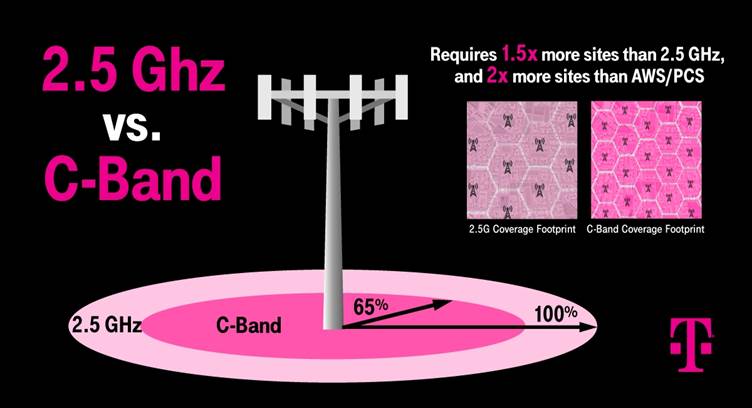T-Mobile last week announced that it has invested just over $9.3 billion in the FCC’s C-Band auction, selectively acquiring additional mid-band spectrum it will use to roll out 5G network.
T-Mobile won an average of 40 MHz of C-Band in key areas home to nearly 225 million people, which it will deploy to add additional depth to its already strong 5G network, bringing even greater speed and performance. In the mid-band range, C-Band offers a great mix of coverage and speed, but there are some key differences from 2.5 GHz, the mid-band spectrum T-Mobile is primarily using to roll out 5G network.
Most notably, it doesn’t travel as far. T-Mobile engineers estimate it will require 50% more cell sites for meaningful and continuous coverage, and in some areas, for example in-building, the required densification can be 4x higher than 2.5 GHz. That’s why T-Mobile strategically invested in C-Band to supplement its much broader 2.5 GHz footprint in select urban and suburban areas where it already has a dense network. This will allow for the spectrum to quickly be deployed and provide a more meaningful performance boost for customers.
T-Mobile said building the its 5G network didn’t happen by chance. It took years of planning and investment – first for low-band 600 MHz spectrum to provide a massive nationwide coverage layer of Extended Range 5G – then for mid-band 2.5 GHz from Sprint to bring game-changing speed and performance to more people. And with spectrum dedicated to 5G in low-, mid-, and high-bands, T-Mobile claims that it is the only provider currently positioned to deliver innovations like standalone 5G and 5G Carrier Aggregation, expanding 5G coverage, improving network response times, and combining different layers of capacity for greater speed and performance.
Mike Sievert, CEO of T-Mobile
As I predicted last fall, the other guys spent an unbelievable amount — because they had to. And even then, the truth is that C-Band is best for urban areas because it doesn’t propagate as well as T-Mobile’s substantial existing mid-band frequencies.
Neville Ray, President of Technology at T-Mobile
Simply put, Verizon and AT&T bet on the wrong horse — went all in on millimeter wave — and now they’re scrambling … and writing big checks … to try to catch up. Meanwhile we’re on track to deploy Ultra Capacity 5G nationwide before they can even get their hands on C-Band.




















